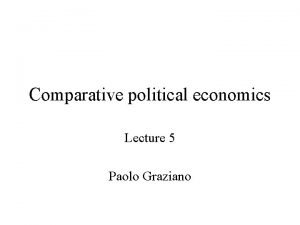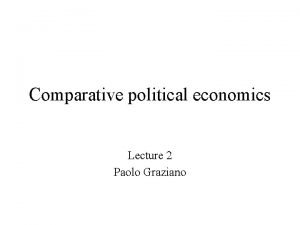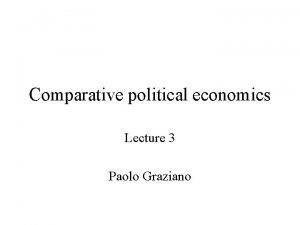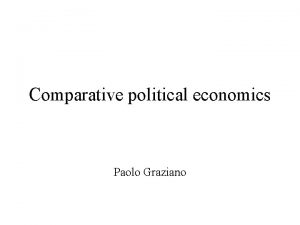Comparative political economics Lecture 4 Paolo Graziano ExecutiveLegislative













- Slides: 13

Comparative political economics Lecture 4 Paolo Graziano

Executive-Legislative Relations • • where is power? different types of government… but also different types of power relations. ‘democratic’ need for a balance of power presidential system parliamentary system semipresidential system prime ministership

Presidential system • head of government is elected for a predefined period and usually cannot be forced to resign by a vote of no confidence • presidents are directly elected • one-person, noncollegial executives • ex: US, Colombia, Costa Rica, Venezuela

Parliamentary system • head of government is responsible to the legislature (i. e. dependent on the legislature’s confidence and can be dismissed by a legislative vote of no confidence or censure) • prime ministers are selected by legislatures • collective or collegial executives • ex: United Kingdom, Germany

Semipresidential system • mix of both presidential and parliamentary features • president directly elected… • … but with power to be shared with the prime minister… • … appointed by the president by responsible to the legislature • possible ‘cohabitation’ • ex: France, Ireland, Finland, Austria, Iceland, Portugal

Prime ministership • prime minister is responsible to the legislature but. . . • directly elected and not selected by the legislature (possible ‘mutual dismissal’) • formally collegial executives, but often non collegial executive (prime minister predominance) • ex: Israel (1996 -2001)

Executive dominance I • what is the indicator of executive dominance? • cabinet durability: a long-lasting cabinet is likely to be dominant… • … and able to make sound decisions, but… • … policy adoption differs from policy implementation. • relevance of top bureaucrats with respect to the overall performance of democracies.

Executive dominance II • how can we measure executive dominance? • average cabinet I: cabinet ends with new elections, new prime minister, new party composition • average cabinet II: party composition • index of executive dominance: mean of measures I and II • United States vs United Kingdom

Electoral systems • electoral formula: plurality/majority vs. proportional system • district magnitude: single-member vs. plurality districts • electoral threshold • total membership of elected body • presidential/legislative elections • malapportionment: unequal voting population • interparty electoral links: vote combination

Disproportionality • aggregate vote-seat share deviations • does proportionality mean ‘more’ democratic? • links between electoral and party systems: – all electoral systems tend to yield disproportional results – all electoral systems reduce electoral parties – all electoral systems can create a parliamentary majority for parties non supported by a majority of votes

Interest groups • pluralism vs. corporatism • meanings of corporatism: – groups are organized into national, specialized, hierarchical, and monopolistic peak organizations – incorporation of interest groups into the policy formation

Key elements of corporatism • it assures concertation – i. e regular consultation by the leaders of peak organizations with each other and with the government – that arrives at comprehensive binding agreements (tripartite pacts) • IG are – large in size and small in number – coordinated into national peak organizations

Patterns of democracy: a critique • challenging in its research design and useful as a overall introduction to key political concepts but: – very (too? ) ambitious, but not always very accurate (ex: Eu compared to other countries) – conceptual ambiguities (ex: plural vs. non plural societies…) – inadequacy of analytical criteria (es: independence Central Bank in the Federal-Unitary dimension)
 Paolo graziano anatomia patologica
Paolo graziano anatomia patologica Almerindo graziano
Almerindo graziano Graziano diritto canonico
Graziano diritto canonico Graziano and raulin
Graziano and raulin Mariano graziano
Mariano graziano Summary of othello by william shakespeare
Summary of othello by william shakespeare Roderigo archetype
Roderigo archetype Graziano serragiotto
Graziano serragiotto Graziano and raulin
Graziano and raulin 01:640:244 lecture notes - lecture 15: plat, idah, farad
01:640:244 lecture notes - lecture 15: plat, idah, farad Land use planning lecture notes
Land use planning lecture notes Health economics lecture notes
Health economics lecture notes Principles of economics powerpoint lecture slides
Principles of economics powerpoint lecture slides Economics and political science relationship
Economics and political science relationship
























